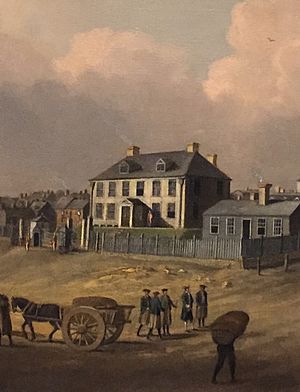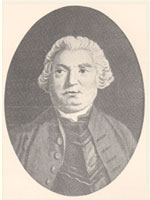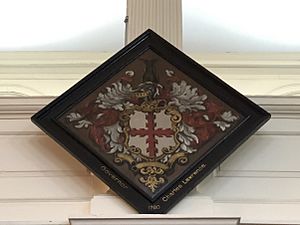Charles Lawrence (British Army officer) facts for kids
Quick facts for kids
Charles Lawrence
|
|
|---|---|
 |
|
| Born | 14 December 1709 Plymouth |
| Died | 19 October 1760 (aged 50) Halifax, Nova Scotia |
| Allegiance | British |
| Rank | Brigadier general |
| Battles/wars | |
| Other work | Governor of Nova Scotia |
Charles Lawrence (born December 14, 1709 – died October 19, 1760) was a British military officer. He became the lieutenant governor and later the governor of Nova Scotia. He is most known for leading the Expulsion of the Acadians and for helping New England Planters settle in Nova Scotia.
Lawrence was born in Plymouth, England. He passed away in Halifax, Nova Scotia. Historians describe him as a "competent" and "efficient" officer. He was trusted by important leaders of his time. Charles Lawrence is buried in the crypt of St. Paul's Church in Halifax.
Contents
Early Life and Military Career
Charles Lawrence was born in Plymouth, Devon, on December 14, 1709. His father, General Charles John Lawrence, was also a military man. Charles followed in his father's footsteps.
Not much is known about Lawrence's very early life. He joined the 11th Regiment of Foot. From 1733 to 1737, he served in the West Indies. After that, he worked at the War Office.
He became a lieutenant in 1731 and a captain in 1745. During the Battle of Fontenoy in 1745, he was wounded while serving with the 54th Foot.
Serving in Father Le Loutre's War

In 1749, during Father Le Loutre's War, Lawrence moved to the 40th Foot. He took part in the Battle at Chignecto in 1749.
In the fall of 1750, he oversaw the building of Fort Lawrence. This fort was on the south bank of the Missaguash River. The same year, he was promoted to Lieutenant-Colonel.
In 1753, Lawrence helped settle the Foreign Protestants in Lunenburg, Nova Scotia. He also stopped a rebellion by some of these settlers. Lawrence used rangers to prevent the Acadian Exodus and to fight the Mi'kmaq people.
Role in the French and Indian War
During the French and Indian War, Lawrence worked with Governor William Shirley of Massachusetts. They helped gather forces for the Battle of Fort Beauséjour on June 16, 1755.
Lawrence wrote the order for the Expulsion of the Acadians. He planned the different campaigns for this expulsion, starting with the Bay of Fundy Campaign in 1755. After a raid on Lunenburg in 1756, he offered a reward for male native scalps.
As governor, Lawrence also helped New England Planters settle on the lands that the Acadians had left. In 1757, Lawrence became a brigadier general. He led one of the three divisions during the successful siege of the French fortress at Louisbourg in 1758. This fortress was on Île Royale (Cape Breton Island).
Death and Legacy
Charles Lawrence is believed to have died from pneumonia in 1760 in Halifax, Nova Scotia. He is buried under St. Paul's Church.
A monument was built in his memory at St. Paul's Church in Halifax. This shows how popular he was. The General Assembly voted to honor him after his death. This suggests that many people respected him, even though some historians criticize his actions towards the Acadians.
Lawrence's name lives on in several places:
- Fort Lawrence, Nova Scotia
- Lawrencetown, Nova Scotia
- Lawrence Street in Lunenburg
- A British privateer ship named Lawrence



